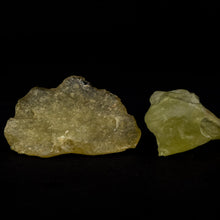Between the towering dunes of the Eastern Great Sand Sea of Egypt are long narrow gaps where bedrock is exposed. It is in these areas of exposed surface that a wondrous natural glass is found. Libyan Desert Glass is the remaining evidence of a tremendous asteroid or comet impact with Earth. Probably an air burst explosion caused the released sufficient heat to melt and fuse to glass the surface of the ground. Libyan Desert Glass is generally yellow in color. It can be very clear or it can be a milky, even bubbly light yellow. Some fragments have dark bands and swirls of brownish material. It is in these dark areas that some of the melted comic body is believed by some to be preserved. Libyan Desert Glass was used in ancient times as a gem stone for the Pharaohs and remains a highly prized impact glass for collectors today. The glass from the Libyan Desert According to today's scientific knowledge this in a pale yellow to green shining impact glass emerged from a collision of a meteorite with earth about 28,5 Mio years ago. In the glowing heat sand melted, splashed up in the air and spread over a 4000 square kilometers sized area in West Egypt. Like with sand, the essential constituent is silicium dioxide, a possible hint of iridium is a indicator for the extraterrestrial origin. Already in palaeolithicum, about 10000 years ago, men discovered this glass. It was used as a substitute for flintstone, one can find artefacts formed as sharp blades and graters. The old Egyptians found a less pragmatic application for this special stone. Even in those times it was considered to be precious and so it become part of religious objects like Tutenkhamon's amulet, there as a carved scarab. Nowdays the Libyan Desert Glass is not only attractive for collectors, esoterism attributes energies for a long and prosperous life to the seldom "rock of the god". Today the way to the find area near the Egyptian-Libyan border leads hundreds of kilometers through arid, desert scaped regions and restricted area. It is a great stone for spiritual work and for group healing. Aligns the energy centers and removes blocks. Egyptian Pharaoh Tutankhamun had a Scarab craved from this stone on his breast plate. A very important stone for the new age. Each of these specimens is golden yellow and semitranslucent, about 1 inch and comes in its own pouch








